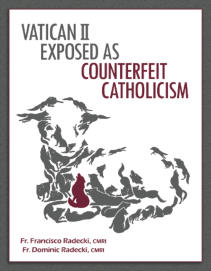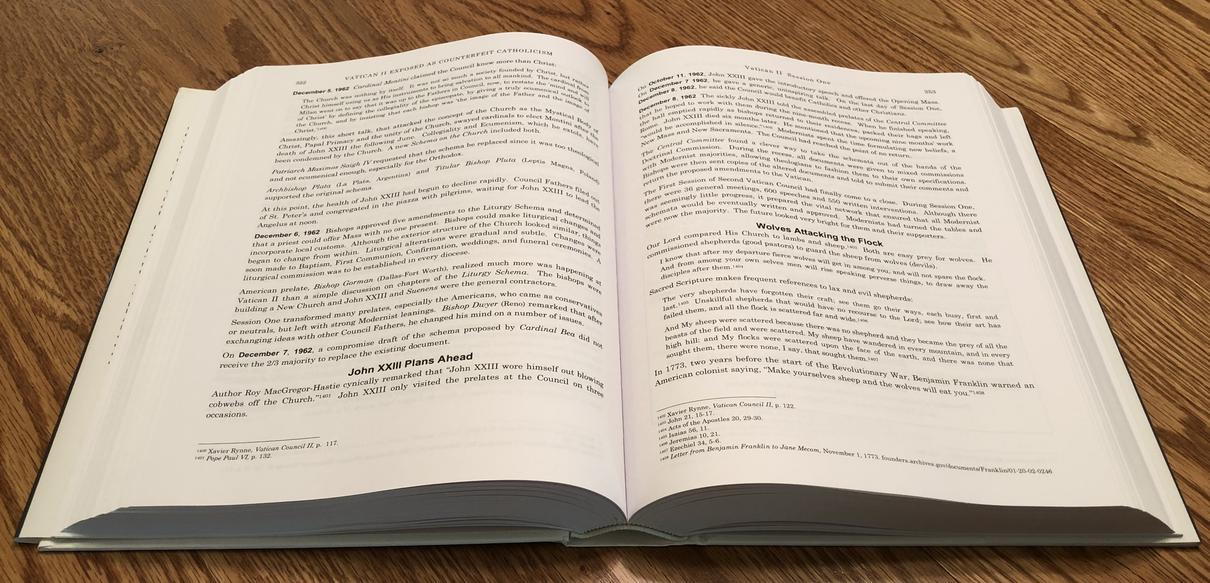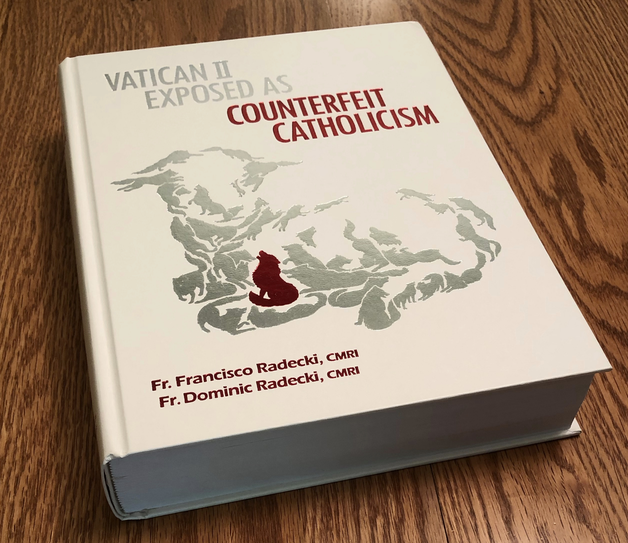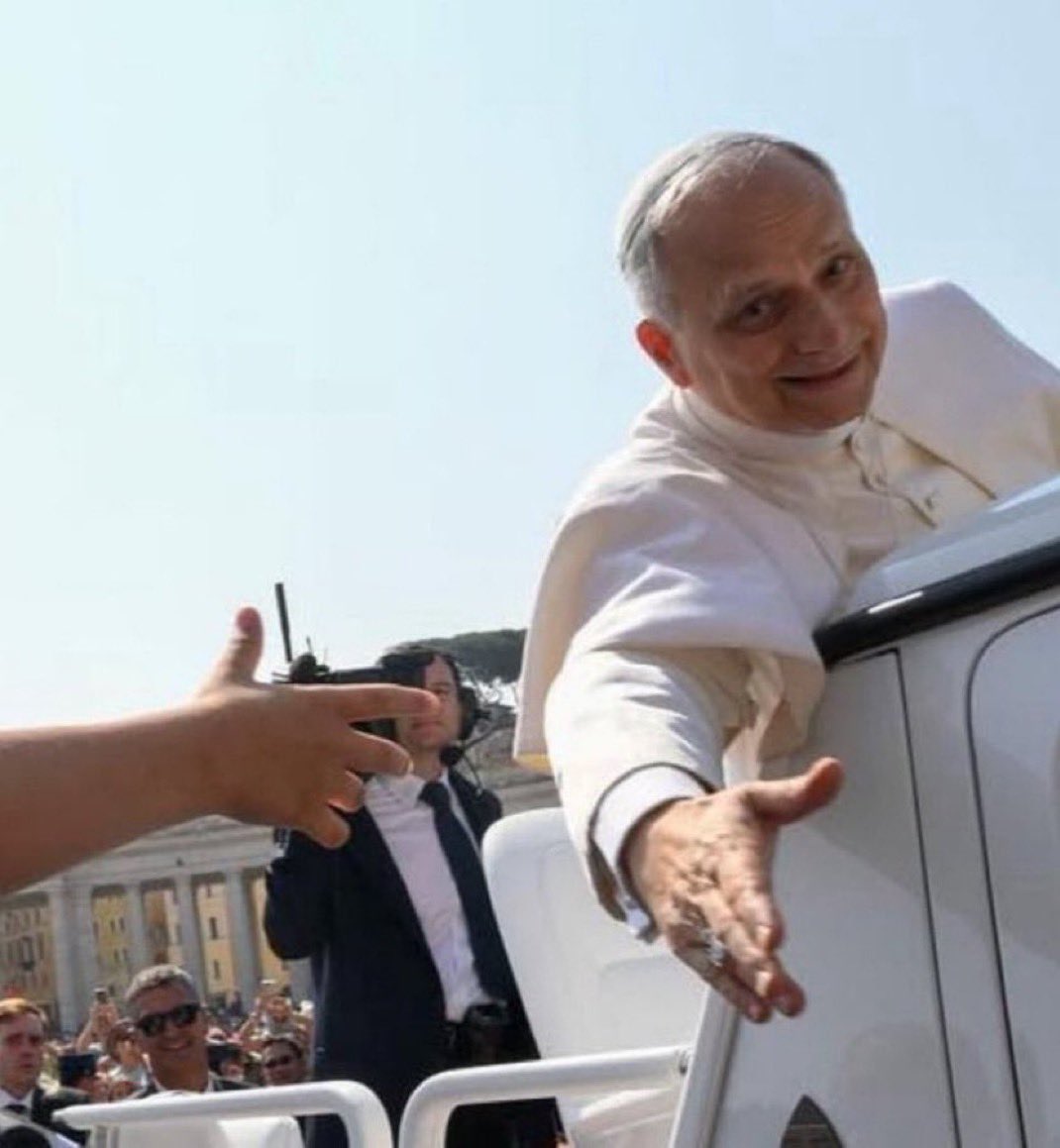Move over, Taylor Marshall…
The Anti-Catholic Religion of the Second Vatican Council:

A Book Review of
Vatican II Exposed as Counterfeit Catholicism
On Mar. 6 of this year, we posted an announcement about a brand-new book exposing the history and heresies of the Novus Ordo religion, its false popes, and its other pivotal players. The work is an 809-page tome called Vatican II Exposed as Counterfeit Catholicism and was written by Fathers Francisco and Dominic Radecki, CMRI:
People interested in buying a copy may do so directly from the authors, at this link (Novus Ordo Watch does not make a commission on the sales). Despite initial plans, it is unlikely that Vatican II Exposed as Counterfeit Catholicism will be available through Amazon.com soon, except perhaps in electronic format.
Vatican II Exposed as Counterfeit Catholicism is a mammoth work of sturdy quality!
We are excited to be able to offer now a sizable review of this book, contributed by a reader of this blog who wishes to remain anonymous. The book reviewer presents a mostly-descriptive Overview (Part 1) followed by a Critical Analysis and Conclusion (Part 2) from the perspective of a simple layman who holds no formal qualifications in theology, history, nor journalism. The opinions expressed in the review are those of the reviewer and not necessarily those of Novus Ordo Watch.
Book Review: Vatican II Exposed as Counterfeit Catholicism
by Fr. Francisco Radecki, CMRI and Fr. Dominic Radecki, CMRI.
Copyright 2019, St. Joseph’s Media
************************************************************************
PART 1: Overview
The first thing that struck me was the size of this book. It is a huge tome, with 757 pages of text, or 809 pages counting the Bibliography. Each page measures approximately 8 and a half inches by 11 inches. The font used is average in size, and the line spacing is generous which makes this book easy to read, insofar as visual comfort. It is a very beautifully presented hardback with dustjacket. The dustjacket is of matching design to the cover itself, but unlike many books, it isn’t hiding, nor making up for, a plain nor inferior cover underneath. The artwork is truly commendable, being both clever in symbolism and elegant in appearance. Very few book covers are so striking for their aesthetically-pleasing quality; implementing a very tasteful color scheme, including metallic red and metallic silver accents, with embossed three-dimensional imagery and text.
Upon opening the book, in the Introduction, we are told:
Why This Book was Written
Vatican II Exposed as Counterfeit Catholicism doesn’t merely tell what occurred at Vatican II, but the who, when, where, why and how. Masterminds, guided by Satan, prepared the way for the creation of the Modern, Counterfeit Church.
The task undertaken by the authors must have been daunting given the quantity and nature of material that they chose to try to somehow sort through. The list of references is probably of the broadest spectrum I have ever come across in one book; the authors certainly cannot be accused of overly-selective resourcing of opinions, viewpoints or accounts. The claims of people from all walks of life, so to speak, have been presented in this volume, ranging from the most authoritative sources such as popes via papal encyclicals, followed by reliable contemporary clergy who are renowned for their theological rectitude, such as Bp. Donald Sanborn (Catholic Restoration), Fr. Noel Barbara, Fr. Anthony Cekada and Fr. Francesco Ricossa (whose articles published in the esteemed priestly periodical, Sacerdotium, made the latter well known to the English-speaking traditional Catholic milieu), right through to such unexpected sources as websites including wikipedia.com, washingtonpost.com, businessinsider.com, strangehistory.net and psywarrior.com. Even the enigmatic Malachi Martin was given a hearing and is quoted at least twice. No one can dare point the finger of “discrimination.”
In view of website articles comprising a substantial portion of the Bibliography (can it still technically be called a “Bibliography” if the reference list includes mostly non-books?), this book obviously doesn’t purport to be a weighty scholarly work — nor do the authors make any such claim. Refraining from pretentious language and extensive theology, they instead use everyday parlance presented in a style that would be comfortable to the average modern mind. Hence, people who get daunted by heavy theological treatises shouldn’t be frightened by the substantial physical size of this book because the approach is very casual overall; and the mode is even conversational in many parts. Consequently, if you aren’t a canon lawyer, nor inclined to pick up the Summa Theologica for your bedtime reading, fear not, because this is nothing like hard-core scholasticism. It seems to be aimed at the common layman who isn’t accustomed to intense academia, nor to rigid and laborious study. Rather, the reader will find within these pages a collection of stories of deception, intrigue, suspicions and allegations of murder, extensive Freemasonic plotting and scheming, shocking examples of disgusting immorality of Modernists even as far back as before the Second Vatican Council – and worst of all, the unspeakable tragedy of the widespread loss of Faith of countless clergy, of all ranks, even up to the highest positions in the Church, which led to the unprecedented catastrophe of the near-universal loss of Faith, which renders the 20th century not only the allegedly “bloodiest of centuries” but surely the most reprehensible.
As part of an attempt to organize what would seem to many people an overwhelming amount of information, numerous lists and tables were formulated, including, but not limited to, those with the following titles:
- European Modernist Training Centers
- French Modernists
- German Modernists
- American Modernists who Attended Vatican II
- Belgian Modernists who Attended Vatican II
- Dutch Modernists who Attended Vatican II
- Italian Modernists who Attended Vatican II
- Modernists from Formerly Communist Countries who Attended Vatican II
- Commissions Controlled by Modernist Cardinals
- Various Addresses of Pope Pius XII
- John XXIII’s Meetings with Representatives of Other Religions
- Members of the International Theological Commission
A large portion of the book is devoted to the documents of Vatican II. Though this is contained in only five chapters out of 31, viz. Chapters 18 through 22, it spans pages 283 through 514. Each of the six recent antipopes, from Roncalli/John XXIII through Bergoglio/Francis, has a chapter devoted specifically to him, as does Pope Pius XII, and there are chapters discussing the Novus Ordo invalid Mass and invalid sacraments, as well as the valid Tridentine Mass.
When reading some of the tales of the characters in the events surrounding the whole disaster of Vatican II and its aftermath, “The Good, the Bad and the Ugly” came to mind; not the movie itself, which I’ve never seen and therefore wouldn’t be recommending, but merely the title. Sadly, “the good” are pitifully few in number (there are only 18 people in the list presented on page 127 of “Cardinals and Bishops who Opposed Modernism”), and these few are overwhelmingly outnumbered by “the bad” who are also “the ugly” due to their ugly beliefs and actions of which they seemingly remained unrepentant (there are about 193 people listed in the tables of Modernists from various nations, presented on pages 54 through 126).
PART 2: Critical Analysis and Conclusion
Some Notable Pros
- The extensive lists of the names of Modernists (“the bad” and “the ugly”) who were actively attacking the Church around the time of Vatican II, could prove useful to refer to, or commit to memory if nearly 200 names is within one’s memorizing capacity, when reading any material of a religious nature published between the late 1800s through to the 1960s. Unfortunately, even writings bearing an Imprimatur carry no guarantee of orthodoxy nor harmlessness, especially in view of the insidious and deceptive manner in which Modernists operate. Hence, for example, if one has a book with an Imprimatur from, say, 1950, that is written by, or even based on ideas held by, any of these Modernists, one would know to beware.
- In Chapter 24, “Preparing the Ground for the New Mass”, enough information is presented for the reader to conclude that the Novus Ordo Missae didn’t just get dropped suddenly like a bomb. Rather, the principle of gradualism, combined with tenacious cunning, was employed by conspiring Modernists to desacralize the liturgy, introducing heretical and dangerous elements as far back as the 1920s; and even earlier trial balloons occurred in a localized manner.
- The untrustworthiness of Modernists and their modus operandi of cleverly crafted deception techniques, combined with bully tactics when needed, is really rammed home throughout this book. We are alerted to always be wary because in spite of artful phraseology in attempts to disguise what they really mean, everything they say should be presumed to be intended to work toward their evil agendas.
- The information presented in the chapters specifically about the Second Vatican Council, taken as a whole, is sufficient for the reader to conclude that the main characters involved and their Modernist errors (“the bad” and “the ugly” again) formally brought into existence an entirely different religion to the Catholic Faith. Moreover, this undoubtedly was their intention, as evident from their own words.
Some Caveats
- The initial outlines of Freemasonry and Modernism seem a bit hazy. If the reader had no prior knowledge of the nature and history of them, the background provided in this book, alone, wouldn’t provide a sufficiently thorough foundation, nor a very clear understanding, which would be required for properly grasping the full import of what is presented afterwards about the activities of the Freemasons and Modernists in the Church, State and society in general. Before handing this book to anyone new to Sedevacantism, it would be advisable to have them study some encyclicals on these subjects, such as Pascendi Dominici Gregis and Humanum Genus and books such as Fr Denis Fahey’s The Kingship of Christ and Organized Naturalism to provide a more solid base. Near the end of the book, the authors do recommend and reference Pascendi Dominici Gregis, but reading that encyclical prior to starting this book would probably be beneficial for everyone.
- The overview provided regarding the Bugnini Holy Week liturgical changes of 1955, mostly on pages 169-171, sufficiently explains the viewpoint of those clergy who hold the opinion that it is fine to keep using those changes. However, the position held by sedevacantist clergy who reject the use of this interim liturgical form was presented in a way that would likely lead the reader to an inaccurate apprehension of the issue. It seems that the authors mustn’t have come across the number of articles available on traditionalmass.org explaining their rationale. Reading those articles (and for those who like videos, viewing Fr. Anthony Cekada’s recently released presentation on this topic) should suffice to dispel any false notions. It should be noted that the authors clearly respect Fr. Cekada’s scholarship, as attested to by his booklet, “Sedevacantism, A Quick Primer” being quoted at length on p. 236 – in addition to two books and one article by the same author also being referenced in a favorable light.
- Numerous Modernists are exposed by name, yet when they are quoted it sometimes seems that their words are to be taken as being in some way credible, despite what is made clear about Modernists as mentioned in Pro #3 (above). Most of the time what the Modernists are quoted to have said or done is obviously included in the book to demonstrate their devious scheming and heretical beliefs; however, there are places where the reader could get the impression that their words are being used as a verification. As an example, in line with the topic of Caveat #2 (above): a Fr. Antonelli is quoted on p. 169 as criticizing the pre-1955 Holy Week liturgy (an entire paragraph of his is presented on that page) and the authors distill his quote as remarking “how the phrases ‘splendor of the night,’ ‘blessed night’ and ‘holy night’ are inappropriate when ceremonies are performed on Holy Saturday morning.” Yet, on p. 557, Fr. Antonelli (who is definitely the same person as the previously quoted Fr. Antonelli, as evident from this book which refers to the same source) is manifested as a clearly questionable source – whose opinion should be presumed to be in support of the Modernist agenda – by the following statement: “Fr. Fernando [sic] Antonelli, who revered the writings of Beauduin and Casel, was a close friend of Botte, Jungmann and Martimort.” Similarly, Abp. Bugnini is listed on p. 108 as a “Freemason” who “Helped Write the New Mass” and is exposed in great detail throughout the book for the scheming Modernist that he was, including on p. 109: “As chief architect of the New Mass, Bugnini worked with liturgical committees before, during and after Vatican II. If he ran into opposition, Bugnini would merely say, ‘The pope wills it,’ and continue.” On p. 557, it states, “Bugnini, the driving force behind liturgical change, boldly declared, ‘I am the liturgical reform!’ His methods were so chaotic and hurried that Paul VI told him to slow down. When one considers the incompetent men who formed the New Mass and New Sacraments, it is no wonder they turned out so poorly.” All this justifiable criticism of Bugnini and his liturgical havoc seems inconsistent with the overall sense of praise given by the authors for his 1955 liturgy. Another example of how possible confusion could result from what might seem a mixed message, is the Dialogue Mass. It is presented in a way that one could think there are no problems associated with it, viz., in the chapter describing the Tridentine Mass vs. the New Mass, in a section titled, “Active Participation in the Liturgy”, it states: “The Faithful are encouraged to join the choir in singing the various parts of the Mass or hymns during a Sung Mass (Missa Cantata) or to answer Latin responses of the priest during the Dialogue Mass.” Some readers may not be aware that the majority of scholarly works since Vatican II which substantially address the Dialogue Mass consider that it was used as a stepping-stone to the Novus Ordo Missae, encouraged by Modernists. This led to the concept of the inability to offer Mass when there is no congregation present, which then led to the Novus Ordo concelebration nonsense; so one can certainly question its prudence.
- On page 201, it states that “Holy Scripture foretold that before the coming of Antichrist, the protective power of the papacy would be eliminated” and St Paul, 2 Thessalonians 2:7, is quoted as referring to this, as follows: “St Paul wrote: For the mystery of iniquity is already at work; provided only that he [the pope] who is at present restraining it, does still restrain, until he is gotten out of the way.” Some readers might presume that the phrase “the pope” inserted in square brackets is referring to an explicit mention of “the pope” occurring in the surrounding text of Scripture, thus indicating that that meaning of the pronoun “he” is self-evident. However, that is not the case, so the distinction between that being merely an opinion and not fact, must be made. Scriptural exegetes are divided as to what that passage might mean which reminded me of a section in Rev. E. Sylvester Berry’s book, The Apocalypse of St. John, where he similarly propounds such a possibility, on pages 121-122. Whereas the 1940s’ Dominican Fr. H. M. Feret in his book on the same subject presents a completely different approach, founded on doctrine and history, being devoid of speculations.
- Towards the end of the book, the authors state: “Hopefully, this book will inspire readers who have never attended the Tridentine Latin Mass to see what they have been missing”, followed by directing readers to the CMRI website to access a list of where some such Masses are being offered in the United States. However (unless I overlooked a statement to the contrary), after leading the reader to the conclusion that the Novus Ordo Counterfeit Church is not Catholic, one might be led to be content with assisting at FSSP (Fraternity of St. Peter) or SSPX (Society of St. Pius X) Masses, since they are “valid” Tridentine Masses (assuming the priest is validly ordained, which is a big “if”) because the illicit nature of assisting at such Masses isn’t expressly condemned. Nor could I find an explicit warning for the need to strictly avoid these organizations, entirely, due to their heterodoxy and deviations from orthopraxy. Reading this book will do little good if from it people end up with the SSPX as “crypto-sedevacantists” who assist at the Holy Sacrifice offered in union with heretics. Therefore, one must take very seriously the full ramifications, and practical consequences, implicit in their words: “It is important to realize there is much more at stake than just Mass being offered in Latin. The very foundation of the Church was attacked at Vatican II. This is the time to defend God’s Church, not the time to find excuses to remain in a man-made Church”, and “After reading this book, it is evident that a choice must be made, to either remain faithful to Christ and His Church, or belong to the Counterfeit Church. There is no room for neutrality.” Thus, to make it clear: Organizations of the likes of the FSSP and SSPX, regardless of whatever personal piety and good will the people in them may have, represent precisely this condemnable “neutrality” and constitute part of this antichrist “man-made Church.”
Some Additional Notes about the Bibliography
- Although the format of the referencing doesn’t apparently follow a consistent nor standardized system, the reader should be able to work around this with a little bit of resourcefulness.
- The Wikipedia website features as the most abundant source, followed by Catholic-hierarchy.org.
- Youtube.com video presentations and TV documentaries are included.
- Sometimes the timestamp is included for when a website was accessed and a reference was downloaded. Because of this it can be ascertained that the work of gathering information for this book goes back to at least 2012.
- Mainstream sources as well as those that might be considered “conspiratorial” or “dubious” (albeit the latter are often more trustworthy than the former) are included. Examples from the former category include rollingstone.com, “Rebel Pope” – National Geographic documentary, theguardian.com, nytimes.com, History Channel, CNN.com, bbc.com. Examples from the latter category include, beforeitsnews.com, 2nddegreemasons.org, Chiesa Viva, crisismagazine.com, lifesitenews.com, eyeofthetiber.com, satanic-kindred.org and thedailybeast.com.
- Religious and historical sources both orthodox and heterodox are referenced. Examples of the former include Haydock/Douay Rheims Bible, St. Robert Bellarmine, Dom Prosper Guéranger, Baltimore Catechism, Fr. Reginald Garrigou-Lagrange, Msgr. Philip Hughes and G. K. Chesterton. Examples of the latter include EWTN, Teilhard de Chardin, Yves Congar, Masonic Book Club, “Cardinal” Walter Kasper and Hans Kung.
- Winning entry for irony is “Bringing the Sacraments to the People” from the National Catholic Welfare Conference, Inc, 1966, being right before the sanctioned attempts to annihilate the possibility of bringing sacraments to any people, by the imposition of invalid sacraments.
- Winning entry for most nauseating is Peggy Noonan’s book entitled, “John Paul II the Great: Remembering a Spiritual Father.” And no need for the ipecacuanha if one has a copy handy of, “Pope Benedict in America; the Full Texts of Papal Talks Given during His Apostolic Visit to the United States,” 2008 – no need to even open the book either; the title, alone, will surely do the job.
- Winning entry for what best exemplifies the era of the millennials is the presence of a pinterest.com reference.
- Winning entry for “You can’t make this stuff up!” is Catholic World Report article titled, “Pope’s former professor: Francis never supported a Marxist-based liberation theology.”
- Modernist gobbledygook award (despite ample competition by virtue of the inherent quality of Modernist talk) goes to Jennifer Cooper’s “Humanity in the Mystery of God: the Theological Anthropology of Edward Schillebeeckx” (due to entries being limited to one category, this one missed out on the “most emetic award”). Runner-up is “Cornerstones of Faith: Reconciliation, Eucharist and Stewardship” by “Cardinal” Thomas Collins, 2013.
- The winner of the shortest book in the world, sight unseen (provided the contents are true to the title, it presumably has no pages in it at all): “The Legacy of Pope John Paul II: His Contribution to Catholic Thought,” 2000.
Once the restoration of the Church has taken place, future generations will likely access the written record to ascertain the many different ways that Catholics in our times assessed and addressed this monumentally horrendous situation; and this book will form part of that written record, which will show the melange of the human reactions to this frightful and awful period of history. It will exist alongside books which present similar subject matter, such as Iota Unum, The Rhine Flows into the Tiber, Peter Lovest Thou Me? and The Great Sacrilege, yet which, unlike Vatican II Exposed as Counterfeit Catholicism, fail to point out that the sedevacantist conclusion is the only logical and true position, with its concomitant responsibility to categorically reject the Novus Ordo Church and its various offshoots in their entirety.
A view of the book with the dust jacket taken off
Again, Vatican II Exposed as Counterfeit Catholicism may be purchased directly from the authors here (quantity discounts available).
Image source: stjosephsmedia.com / own creation
License: with permission / n/a







No Comments
Be the first to start a conversation